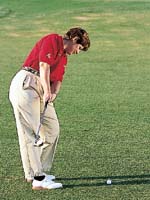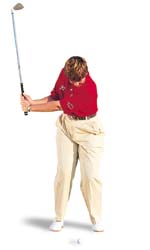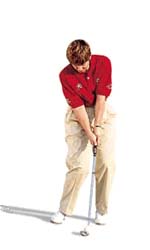Stabilize the Lower Body and Hinge the Wrists to Hit Crisp Half-wedge Shots
One of the most difficult shots in golf is the half-swing wedge. Unfortunately for many women, it’s also one of the most common. Hampered by a lack of distance, they have a hard time reaching some greens in regulation and are therefore left with many 40- and 50-yard approach shots.
 What makes the half-wedge shot so difficult? One reason is the short, compact nature of the swing. Unlike a full swing, there’s not enough time to re-route the body and club should they go off-line. Also, golfers tend to decelerate the clubhead at impact on half-wedge shots, when in reality they should be speeding up their motion, specifically the rotation of their chest.
What makes the half-wedge shot so difficult? One reason is the short, compact nature of the swing. Unlike a full swing, there’s not enough time to re-route the body and club should they go off-line. Also, golfers tend to decelerate the clubhead at impact on half-wedge shots, when in reality they should be speeding up their motion, specifically the rotation of their chest.
Two of the most common faults women make with this shot are: 1) too much lower body movement, and 2) not enough wrist hinge. A stable lower body is critical to hitting half-wedge shots. If your legs are buckling, it’s difficult to control the club and deliver a crisp blow to the ball. The key is to maintain the same height at your knees-slightly flexed throughout the shot. This stabilizes the lower body and quiets the hips, both necessary for such a delicate shot.
A proper wrist hinge is critical because it is your swing’s braking mechanism. It’s almost impossible to control distance if your swing doesn’t have a stopping point on the backswing. Without one, golfers are forced to decelerate: The club moves too far back so they apply a brake to the swing to try to control distance. This usually leads to a thin or fat shot.
The tendency is to hinge the right elbow and not the wrists during the backswing. To reach the proper position, you must turn your chest directly away from the target and hinge the wrists, which allows you to control distance.
Rehinge your wrists after impact and finish in perfect balance. Keep your eyes focused on the target.

